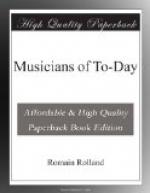Nowhere is Wagner nearer to Beethoven than in Siegfried. In Die Walkuere certain characters, certain phrases of Wotan, of Bruennhilde, and, especially, of Siegmund, bear a close relationship to Beethoven’s symphonies and sonatas. I can never play the recitative con espressione e semplice of the seventeenth sonata for the piano (Op. 31, No. 2) without being reminded of the forests of Die Walkuere and the fugitive hero. But in Siegfried I find, not only a likeness to Beethoven in details, but the same spirit running through the work—both the poem and the music. I cannot help thinking that Beethoven would perhaps have disliked Tristan, but would have loved Siegfried; for the latter is a perfect incarnation of the spirit of old Germany, virginal and gross, sincere and malicious, full of humour and sentiment, of deep feeling, of dreams of bloody and joyous battles, of the shade of great oak-trees and the song of birds.
* * * * *
In my opinion, Siegfried, in spirit and in form, stands alone in Wagner’s work. It breathes perfect health and happiness, and it overflows with gladness. Only Die Meistersinger rivals it in merriment, though even there one does not find such a nice balance of poetry and music.
And Siegfried rouses one’s admiration the more when one thinks that it was the offspring of sickness and suffering. The time at which Wagner wrote it was one of the saddest in his life. It often happens so in art. One goes astray in trying to interpret an artist’s life by his work, for it is exceptional to find one a counterpart of the other. It is more likely that an artist’s work will express the opposite of his life—the things that he did not experience. The object of art is to fill up what is missing in the artist’s experience: “Art begins where life leaves off,” said Wagner. A man of action is rarely pleased with stimulating works of art. Borgia and Sforza patronised Leonardo. The strong, full-blooded men of the seventeenth century; the apoplectic court at Versailles (where Fagon’s lancet played so necessary a part); the generals and ministers who harassed the Protestants and burned the Palatinate—all




